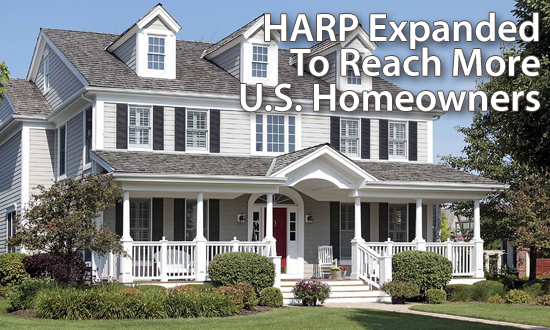HARP Guidelines Changed : Fannie Mae And Freddie Mac Now Qualify Additional U.S. Homeowners For HARP
Mortgage rates and markets change constantly. Stay 100% current by taking The Mortgage Reports by email each day. Click here to get free email alerts, or subscribe to the RSS feed in your browser.

The Federal Home Finance Agency (FHFA) has released a formal HARP update.
Effective immediately, the start date for HARP-eligible loans must be on, or before, May 31, 2009 where "start date" is defined as the note date -- the date on the mortgage. Previously, HARP was only available to homeowners whose mortgages were sold and securitized on, or before, May 31, 2009.
It's a small change, but one that brings the "Obama Refi" closer to HARP 3.
Click here to get today's live HARP mortgage rates.
HARP : Saving Homeowners $21 Billion Annually?
The Home Affordable Refinance Program is nearly 5 years old. It was first introduced in March 2009 as part of that year's economic stimulus, and will be available through the program's December 31, 2015 end date.
HARP is touted as the "underwater mortgage". It makes today's low mortgage rates available to homeowners whose homes have lost value since purchase.
When it was first launched, HARP was timely. Home values were sinking as fast, as were mortgage rates. Homeowners with Fannie Mae- and Freddie Mac-backed mortgages, however, were unable to refinance. They lacked sufficient home equity to qualify for a loan.
HARP mortgage guidelines instructed lenders to overlook a homeowner's loan-to-value (LTV) and to refinance their home loan anyway.
Interestingly, HARP was not billed as a housing market stimulus but, rather, an economic one. The government's goal with HARP was to boost consumer spending.
By giving U.S. homeowners access to lower mortgage rates and payments, the government posited that households would have more available money to spend on goods and services.
How much more? How about $21 billion, based on two government claims about HARP. First, that the program would save the typical U.S. household $3,000 annually; and, second, that it would reach 7 million households nationwide.
After two years, though, it was clear HARP would fall short of its 7-million target. To put the Home Affordable Refinance Program in the hands of more homeowners then, in late-2011, Fannie Mae and Freddie Mac began lifting program restrictions.
Gone was the requirement that HARP loans cap at 125% LTV. Gone was the requirement to use your same mortgage servicer. Gone was the verification of income, assets and credit. Via "HARP 2.0", homeowners could refinance at any LTV with any mortgage lender with fewer hurdles.
The program bore a strange resemblance to the Federal Housing Administration's FHA Streamline Refinance and the Department of Veterans Affairs' VA Streamline Refinance.
HARP was redesigned as the "streamline" conventional refinance and, under the HARP 2 rules, there have been an additional 1.7 million closings.
Now -- again -- Fannie Mae and Freddie Mac are tinkering with HARP.
They've already extended the program deadline by two years this year to December 31, 2015. Now, they're updating the program's eligibility requirements. It's another small step toward the release of HARP 3.
Updated HARP Eligibility Requirements
Mortgage rates today are lower than the government ever expected. As a result, today's HARP-refinancing homeowners are saving more money than the original projections ever predicted they would.
At today's low rates, for example, to meet "$3,000 in annual savings", your original mortgage loan size would have to have been $163,000. This is a small percentage of the U.S. population. Many homeowners borrow more than that and, if you loan size was bigger, your savings are bigger, too.
A homeowner whose original loan size was $250,000 could use HARP to save $4,800 per year, and a homeowner whose original loan size was $400,000 can save $8,000 annually.
Despite these benefits, HARP refinance volume has slowed nationwide.
In August, the number of HARP mortgages fell to its lowest point since the launch of HARP 2.0 and interest in the program appears to waning. Likely, this is an awareness issue because there are millions of U.S. households still eligible to HARP.
Maybe you're among them. The eligibility requirements for HARP are basic :
- Your loan must be backed by Fannie Mae or Freddie Mac
- Your mortgage note date must be on, or before, May 31, 2009
- Your loan must be current, with no "late pays" in the last 6 months
Beyond that, HARP guidelines are similar to other streamlined refinance loans -- documentation requirements are fewer, appraisals can be skipped, and underwriting turn times tend to be faster.
Unless volume increases, though, it's likely that HARP 2.0 will be revamped much like its predecessor.
HARP 3 could feature a host of changes including opening the program to non-Fannie Mae and non-Freddie Mac homeowners; extending the program's start date from May 2009 into 2011; and, allowing the "Re-HARP" of an existing HARP home loan.
A HARP 3.0 bill is currently in committee in Congress. Fannie Mae and Freddie Mac could wait for its passage, or release additional HARP updates on their own.
See Today's Low HARP Mortgage Rates
The HARP program is expanded and available to a wider group of U.S. homeowners than ever before. Plus, with mortgage rates dropping, the opportunity for savings remains huge.
Take a look at today's live mortgage rates and see how the government's HARP refinance can help you save money.
Rates are available online for free, with no cost or obligation.